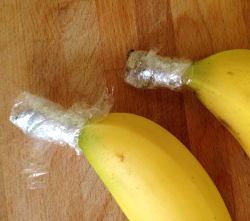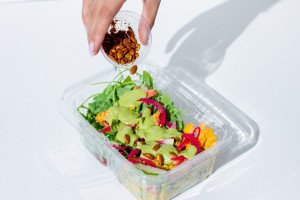How to Keep Bananas from Turning Brown
>> Update! Readers weighed in with a few banana hacks of their own, and we tried them out. Check out those results here.
For the past week, I’ve been channeling my inner Bill Nye (anyone?) and conducting a little experiment in my kitchen. The objective: to find a way to keep my bananas yellower (or, even better, greener) for longer.
The backstory: My house is one of those hot, sad places this time of year that doesn’t have air conditioning, so fruits and veggies left out on the counter turn ripe—and then, overripe—like, overnight. It would all be fine and well if I wanted to eat eight bananas in a sitting, but since my banana intake is exactly one per day—in my morning oatmeal, with walnuts, cinnamon and honey, if you were wondering—I needed to find a way to make them last longer.
Those of you in the thoroughly unpalatable “I like brown bananas!” boat can probably stop reading here. You would have a field day in my house! Left to their own devices, a bunch of bananas will turn completely brown in about two days. Ick.
Since I like my bananas as green as possible—yellow with a couple brown freckles is about as far down the ripeness path as I’ll dare go. Any browner and they get frozen for banana bread—I was desperate to find a way to keep them within my window of edibility for longer. And so I turned to Google, where I found lots of hair-brained-sounding ideas, such as storing them in the basement where it’s cooler or peeling them once they’re at the desired ripeness, wrapping them in plastic, and storing them in the fridge.
Then I found one suggestion that was accompanied by a long-winded scientific explanation as to how and why it works, and I was sold. Read the full explanation here, but here’s the short of it: The main culprit in the banana-browning process is ethylene gas, which is released mainly through the stems and, when it hits other parts of the fruit (or any other fruits or veggies nearby), it causes them to ripen faster. The article suggested wrapping the stems in plastic wrap to prevent the gas from escaping.
“Interesting,” I said, out loud to myself, as I stood in the kitchen alone. “I’m going to try this.”
And so I grabbed some Saran Wrap and my banana bunch and began wrapping. I discovered an immediate problem, though: You can’t get a tight seal on the stems of bananas that are still all together in the bunch; there are gaps through which the gas could escape. So I took a chance and separated the bananas from the bunch and wrapped the stems individually.
It’s a labor of love, sure, but nothing’s too annoying for my green bananas. I found that ripping off a three- or -four-inch-wide section of plastic wrap—so you have a long, skinny rectangle—and cutting it down, width-wise, with a pizza cutter was a good way to get smaller sections sized perfectly for a banana stem. Then you just wrap the plastic around once, tuck the end in, and finish wrapping as many times as you can go around. The plastic doesn’t stick to itself like glue, but it’s sticky enough to keep the gasses in.
And guess what? Eight days after I wrapped them, my last banana (the other seven were loooong gone) was just turning yellow with some brown freckles. Not bad! The others stayed green for four full days before slowly, but surely, turning yellow. How’s that for some serious shelf-life?
>> What produce-storage hacks have you discovered? Tell us in the comments!



